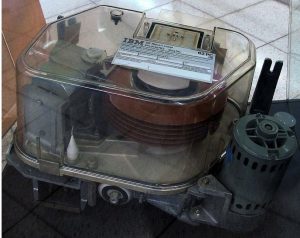History (1979): Hard Disk Diameter Shrinks to 8 Inches
Small business computers require smaller physical size HDDs.
This is a Press Release edited by StorageNewsletter.com on May 14, 2018 at 2:21 pmThis article comes from the Computer History Museum.
1979: Hard disk diameter shrinks to eight inches
Small business computers require smaller physical size HDDs
IBM 62PC unit

The move to smaller and lower-cost business and engineering computer installations in the late 1970s, such as the IBM 4331 and minicomputers from Data General, DEC, Hewlett-Packard Prime, Wang, and others, initiated a transition from 14-inch to 8-inch diameter disks.
The IBM 62PC (Piccolo) 65MB capacity drive introduced in 1979 used six 8-inch disks with one surface dedicated to servo position data. The drive employed a sector servo position control and a rotary voice coil actuator to eliminate temperature effects. The lower power consumption of the small disk diameter eliminated the need for external air cooling and simplified integration of the unit as subsystem into a variety of machines. A sealed disk enclosure design assured a reduction in disk surface contamination and improved reliability. IBM also sold the unit as the 3310 attachable direct access storage device (DASD). 360,000 units were shipped from Jan 1979 through Feb 1990.
Six other vendors (BASF, International Memories, Micropolis, New World Computer, Pertec, Shugart Associates) introduced competing 8-inch drives in 1979. Priam and Quantum followed shortly after.
The small physical size and low power requirements of models with capacities of 10, 20, 30, and 40MB proved popular with minicomputer users even though the initial cost per megabyte was higher than that of older 14-inch drives.
Just one year after the Piccolo, in 1980 Seagate Technology introduced a 5.25-inch diameter disk drive to address the even smaller physical size and power consumption demands of the burgeoning personal computer market.













 Subscribe to our free daily newsletter
Subscribe to our free daily newsletter

